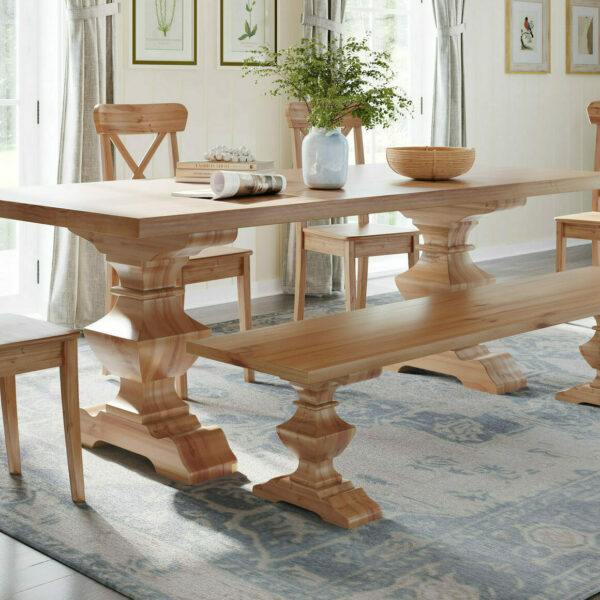How to Maintain and Care for Your Dining Room Table Legs
How to Maintain and Care for Your Dining Room Table Legs
Blog Article
From Typical to Modern: Find the Ideal Dining-room Table Legs for Your Design
While classic designs such as cabriole and transformed legs stimulate a feeling of ageless class, contemporary styles like hairpin and geometric choices offer an opportunity for striking aesthetic passion. As you think about these components, the inquiry stays: how can you perfectly integrate these diverse leg designs to create a harmonious dining experience?
Recognizing Table Leg Styles
The selection of eating space table leg styles can significantly influence both the visual appeals and functionality of the room. Each leg design contributes unique aesthetic components and functional functions, satisfying varied design choices and use requirements. Recognizing these designs is essential for selecting the appropriate table that aligns with your total interior decoration vision.
As an example, tapered legs offer a clean, classic appearance that can enhance an area's beauty, while stand bases supply stability and maximize legroom, making them perfect for smaller sized spaces. Barrette legs, a characteristic of mid-century modern-day layout, present an industrial style, enabling an airy, open feel. Trestle legs stimulate rustic beauty, offering durable support and a feeling of eternity.
Wooden legs can bring heat and structure, whereas steel options commonly communicate a smooth, contemporary vibe. Eventually, recognizing table leg designs is essential for creating a natural dining area that mirrors personal design while ensuring practicality and comfort.
Standard Table Leg Options
When picking dining-room table legs, typical options frequently personify classic beauty and workmanship. These styles reflect a rich heritage and a commitment to quality, making them perfect for those who value timeless aesthetics.
One of one of the most famous typical leg designs is the cabriole leg, identified by its elegant bent form. This style commonly includes ornamental carvings and is most typically discovered in Queen Anne and Chippendale furniture. An additional preferred choice is the transformed leg, which flaunts a collection of smooth, rounded forms that provide a classic look while keeping security.
Moreover, the straight leg, while simple, uses a basic and tough framework that can mix flawlessly with a variety of tabletop designs. For those drawn to ornate detailing, claw-and-ball feet legs evoke a sense of grandeur and can offer as a magnificent centerpiece in any eating area.
Finally, pedestal bases, although not purely legs, offer an alternative standard option that permits for adequate legroom and can be wonderfully carved. Each of these conventional leg designs adds to the total atmosphere of a dining room, marrying feature with aesthetic allure.

Modern Table Leg Styles
Modern table leg layouts provide a varied variety of designs that highlight cutting-edge products and clean lines. These designs usually focus on performance while offering as striking prime focus within a dining area. Minimal visual appeals are prevalent, with legs crafted from materials such as steel, glass, and crafted timber, which add to a contemporary and ventilated feeling.
One prominent design is the barrette leg, characterized by its slim, conical structure that provides stability without overwhelming the tabletop (dining room table legs). This style is frequently found in mid-century contemporary furniture and can effortlessly enhance numerous dining table forms. One more fad is making use of geometric shapes, where legs may tackle angular or unbalanced types, adding aesthetic rate of interest and a touch of artistry

Mixing Designs for Unique Areas
Frequently, home owners seek to produce special eating spaces that mirror their personal style by blending numerous style elements. This strategy permits the unification of varied aesthetics, causing a harmonious yet distinct atmosphere. Pairing a rustic wood table with streamlined, modern-day metal legs can develop an attractive contrast that elevates the area's general appeal.
In addition, integrating vintage table legs with modern table tops can evoke a sense of background while keeping a modern sensibility. Such mixes not just display individual preference yet additionally urge creative thinking, allowing house owners to curate a space that feels both individual and inviting.
Shade plays a crucial duty in this blending procedure; choosing table legs that complement or contrast with the existing color design can improve aesthetic passion. Whitewashed legs can soften the daring of a dark table surface, creating a go to my site balanced visual.
Tips for Choosing the Right Legs
Picking the right table legs is necessary for achieving both capability and aesthetic allure in your dining room. Begin by thinking about the general design of your area. Traditional settings profit from legs that feature intricate carvings or transformed styles, while modern spaces might call for sleek, minimal styles.
Next, evaluate the elevation and stability of the legs. dining room table legs. Typical table range between 28 to 30 inches in height, so guarantee the legs match this dimension for comfort. Additionally, durable products, such as wood or steel, can improve security and longevity
Examine the leg form as well-- alternatives consist of right, tapered, or pedestal layouts. Straight legs supply a timeless appearance, while tapered legs can add a touch of beauty. Pedestal bases supply enough legroom and are suitable for smaller sized rooms.
Conclusion
In recap, choosing the ideal eating space table legs calls for cautious Homepage consideration of both typical and contemporary designs. By integrating leg design, elevation, and material with the general decoration, a natural and inviting ambience can be achieved.
The selection of dining area table leg styles can dramatically influence both the appearances and capability of the room. Eventually, comprehending table leg styles is essential for producing a natural dining location that reflects personal design while guaranteeing usefulness and comfort.One of the most famous traditional leg styles is the cabriole leg, identified by its graceful rounded form. Straight legs offer a traditional appearance, while tapered legs can include a touch of style.In summary, choosing the ideal dining area table legs published here requires cautious factor to consider of both traditional and contemporary styles.
Report this page